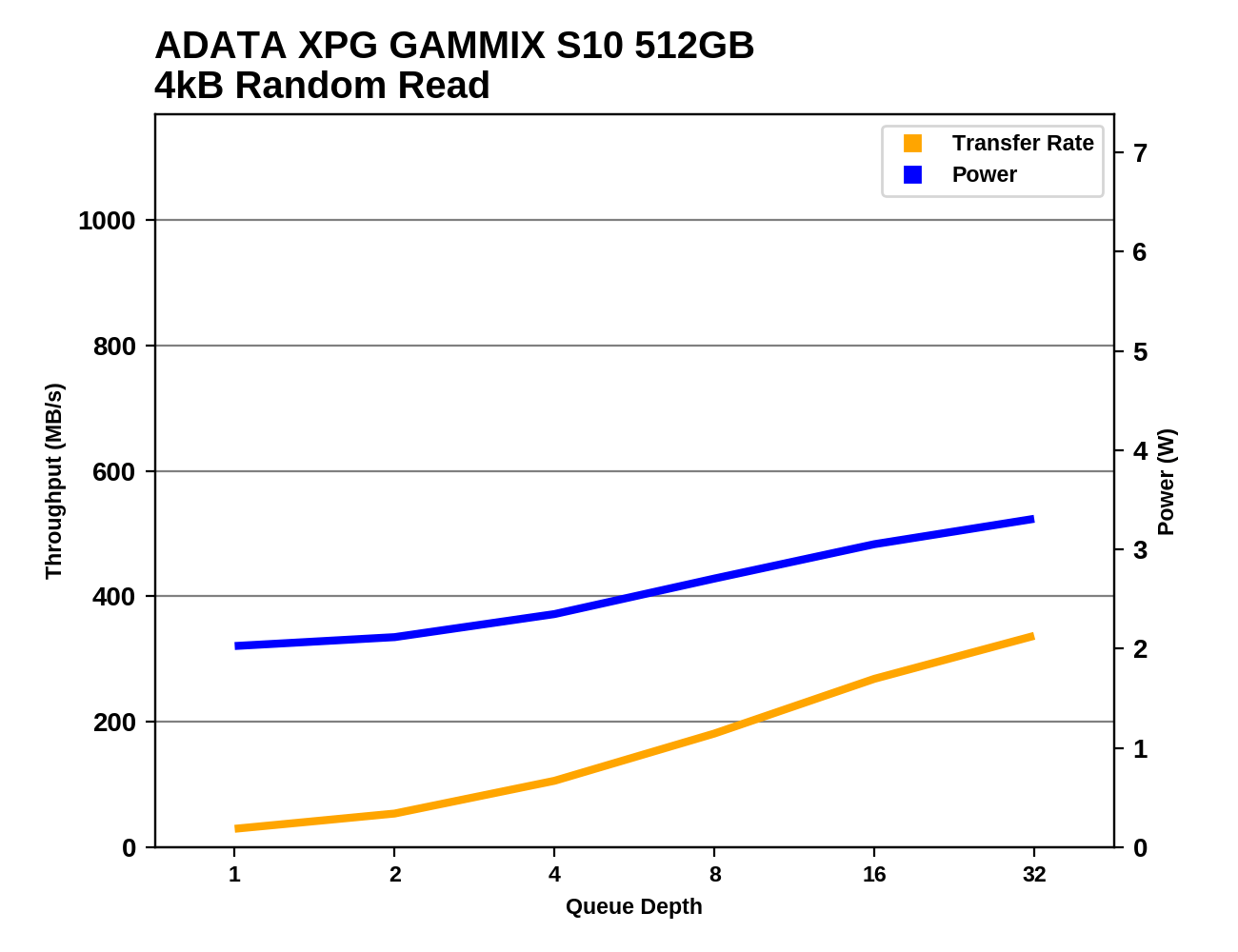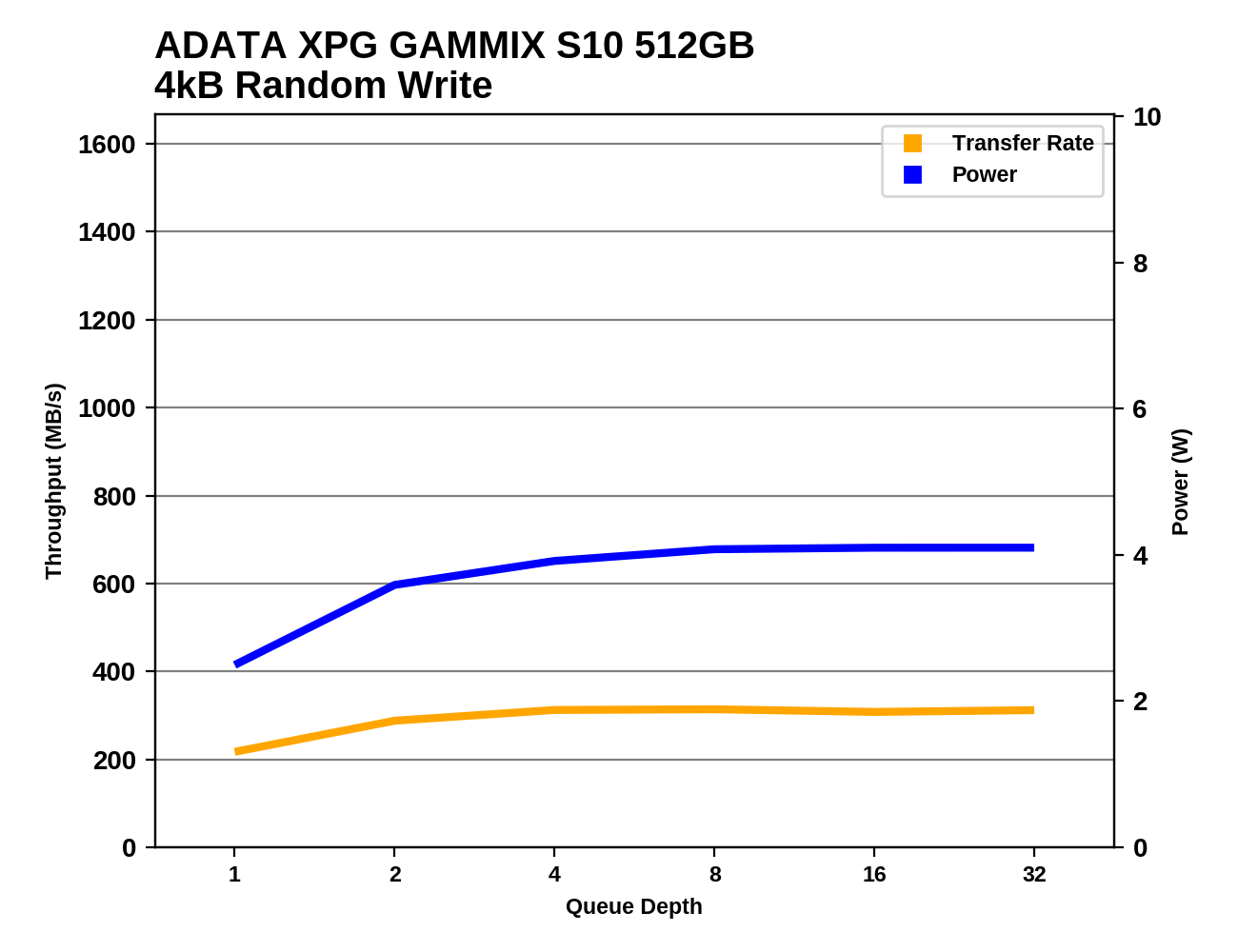The ADATA XPG GAMMIX S10 (512GB) SSD Review: Entry-Level NVMe With Style
by Billy Tallis on October 25, 2017 8:30 AM ESTRandom Read Performance
Our first test of random read performance uses very short bursts of operations issued one at a time with no queuing. The drives are given enough idle time between bursts to yield an overall duty cycle of 20%, so thermal throttling is impossible. Each burst consists of a total of 32MB of 4kB random reads, from a 16GB span of the disk. The total data read is 1GB.

The burst QD1 random read speed of the ADATA XPG GAMMIX S10 is much better than that of the Intel 600p, but still slower than Samsung's SATA SSDs and any other NVMe SSD. The GAMMIX S10 has the highest burst random read speed of any SSD we've tested with Intel/Micron 3D NAND, including the Intel 545s with the second-generation 64L 3D NAND.
Our sustained random read performance is similar to the random read test from our 2015 test suite: queue depths from 1 to 32 are tested, and the average performance and power efficiency across QD1, QD2 and QD4 are reported as the primary scores. Each queue depth is tested for one minute or 32GB of data transferred, whichever is shorter. After each queue depth is tested, the drive is given up to one minute to cool off so that the higher queue depths are unlikely to be affected by accumulated heat build-up. The individual read operations are again 4kB, and cover a 64GB span of the drive.

When higher queue depths and longer run times come into play, the random read speed of the GAMMIX S10 doesn't look so good. It is merely tied with the Crucial BX300 and behind the Intel 545s instead of being the fastest Intel/Micron 3D NAND SSD, and everybody else's flash offers faster random read speeds.

The GAMMIX S10 has poor power efficiency to go along with its poor random read speeds. The best NVMe SSDs using TLC NAND are close to twice as efficient for random reads as the GAMMIX S10.
 |
|||||||||
The Intel 600p and Crucial MX300 are the only SSDs in this bunch that are slower than the GAMMIX S10 at every queue depth. Any other NVMe SSD scales to much higher random read performance as queue depth increases.
Random Write Performance
Our test of random write burst performance is structured similarly to the random read burst test, but each burst is only 4MB and the total test length is 128MB. The 4kB random write operations are distributed over a 16GB span of the drive, and the operations are issued one at a time with no queuing.

The burst random write speed of the ADATA XPG GAMMIX S10 is pretty good for a TLC-based NVMe SSD. MLC-based NVMe SSDs with more powerful controllers can do even better, but the GAMMIX S10's performance is nothing to complain about.
As with the sustained random read test, our sustained 4kB random write test runs for up to one minute or 32GB per queue depth, covering a 64GB span of the drive and giving the drive up to 1 minute of idle time between queue depths to allow for write caches to be flushed and for the drive to cool down.

On the longer test of random write performance, the GAMMIX S10 is slightly faster than the Intel 600p and WD Black, which themselves hold a small advantage over SATA SSDs. Most other NVMe SSDs are quite a bit faster than the GAMMIX S10.

The power efficiency of the GAMMIX S10 during the random write test is not quite as bad as the Intel 600p or WD Black, but it is still poor with performance on par with early NVMe drives like the Samsung 950 PRO and notoriously power-hungry Intel 750.
 |
|||||||||
The random write speed of the ADATA XPG GAMMIX S10 has mostly saturated by QD2, and the top speed it reaches on this sustained performance test is lower than many mainstream SATA SSDs. Most NVMe SSDs of this capacity or larger are able to continue increasing performance as queue depths grow, leading to performance that surpasses the limits of SATA.










27 Comments
View All Comments
rrinker - Wednesday, October 25, 2017 - link
For some reason I thought the black insert was plastic, but it actually doesn't say either way. If plastic, well... You pretty much said what I was skirting around, it's all cosmetic like so many of the weird and funky heat sinks/heat spreaders you see on "enthusiast" gear. There to look cool, doesn't actually do much of anything, either because it's not really needed, the device with the heat sink doesn't actually get all that hot, or it's no more effective than a plain old simple heatsink.Wwhat - Sunday, November 12, 2017 - link
I am absolutely perplexed that anandtech doesn't specify the material of that insert. I mean that is so goddamn relevant.And I'm actually wondering what adata's comment on that insert would be. They should have asked them.
As for needed, all tests have shown a good heatsink on the M2 SSD's does indeed do a world of good. And tests have also shown that half the companies in the world that supply such, either bundled or third party, can't figure out such a simple thing as a piece of aluminium on a freaking small rectangle. I mean how complex is it? But again it's been shown that if you put a good one on it it's always noticeably beneficial.
jjj - Wednesday, October 25, 2017 - link
Don't understand how one imagines a product with that seq read perf.trparky - Wednesday, October 25, 2017 - link
I went to go look at what you were talking about and my first reaction when I saw the graphs was "Ouch! WTF!". It barely matches the performance of a SATA SSD, putting it on NVMe is just a waste.r3loaded - Wednesday, October 25, 2017 - link
If your product is going to get curbstomped in performance by the 960 Evo, at least try to price it at a significant discount vs the 960 Evo.ddriver - Wednesday, October 25, 2017 - link
It is very hard to undersell samsung, they make the memory, they make the controller, they make the pcb. Vertical integration.Now imagine that you have to buy each of those components from someone else, pay profit margins on the components, then put work into making a product out of it, and sell that product with a profit margin for yourself.
It is a pointless endeavor. In a better world, they won't even bother to compete with a vertically integrated company like samsung. But in the world as it is, there are plenty of idiots who will buy this, one way or the other, either for the gimmicky but nice looking heatsink, or it will get it shoved down their throats by an OEM who has a deal with the manufacturer to bundle the product.
The negative aspect of this is that after so many years of domination, samsung will significantly cut on the purchase value of their products, because it still has tremendous lead and could let some of it melt in order to materialize as profits. Upcoming SSDs from samsung, even if a tad faster, will be disappointing compared to what we used to get in the past. Get ready for a slump of TLC and QLC, endurance and warranty period cuts.
Ratman6161 - Wednesday, October 25, 2017 - link
People aren't idiots. They are just uninformed. There is a big difference. For my uninformed friends who either can't or don't want to do the research, my recommendation is always "just buy Samsung and don't worry about it". Or if they want reasonably priced but larger storage with "OK" performance then it's "just buy Crucial and don't worry about it.If you know specifically what you are looking for and know what trade offs you are willing to make there are other choices that fit certain niches. But even knowing what I wanted/needed I ended up with a 512 GB 960 EVO and a 750 GB MX300 (got on prime day last year for $139 :)).
ddriver - Wednesday, October 25, 2017 - link
"People aren't idiots. They are just uninformed."Tomayto, tomahto... If you make a purchase uninformed, that's idiocy right there.
IMO everyone is an idiot, including me. It is not a matter of idiots or non-idiots, at this stage of evolution we are all idiots, it's just that some are more idiotic than others. And the first step to overcoming idiocy is to acknowledge it :) The gradation of idiocy is acknowledgement of it, ignorance of it, mistaking it for something else and finally taking pride in it.
Lolimaster - Wednesday, October 25, 2017 - link
For sata the WD/Sandisk 3D SSD's seems a like a better option than the Crucials.KAlmquist - Friday, October 27, 2017 - link
A vertically integrated company like Samsung still wants to make a profit on its investments into R&D, so the fact that all of the R&D is done by one company doesn't directly help costs. It does remove some of the costs associated with developing and maintaining relationships between companies. For example, Silicon Motion has to market its products to SDD manufacturers, which is an overhead that Samsung's controller development group doesn't have. Another possible cost savings for Samsung is that it knows it's controllers will never be used with anything other than Samsung flash, so it doesn't have to develop a controller that is compatible with multiple brands of flash.